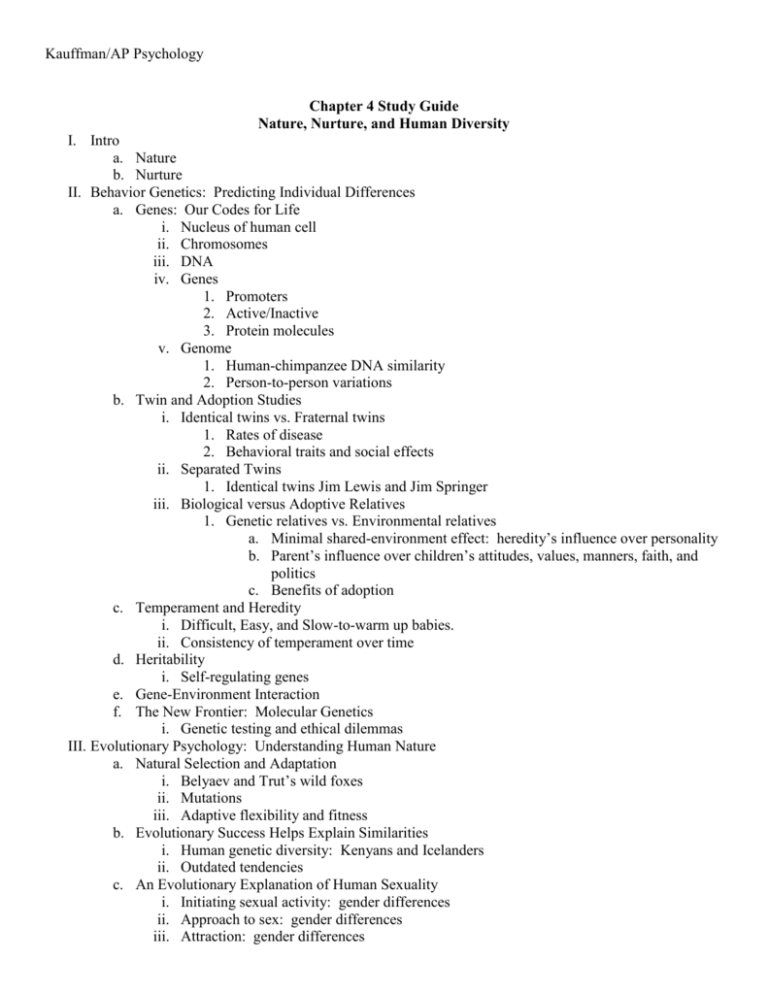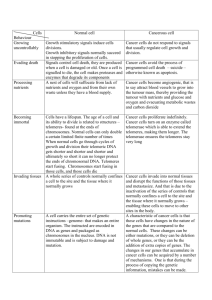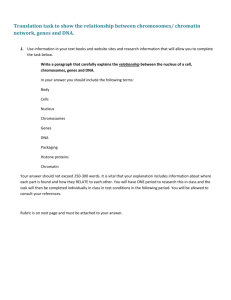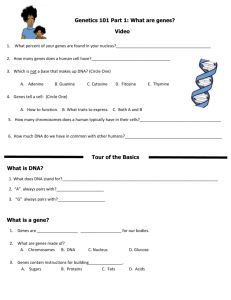b. - Deerfield High School
advertisement

Kauffman/AP Psychology Chapter 4 Study Guide Nature, Nurture, and Human Diversity I. Intro a. Nature b. Nurture II. Behavior Genetics: Predicting Individual Differences a. Genes: Our Codes for Life i. Nucleus of human cell ii. Chromosomes iii. DNA iv. Genes 1. Promoters 2. Active/Inactive 3. Protein molecules v. Genome 1. Human-chimpanzee DNA similarity 2. Person-to-person variations b. Twin and Adoption Studies i. Identical twins vs. Fraternal twins 1. Rates of disease 2. Behavioral traits and social effects ii. Separated Twins 1. Identical twins Jim Lewis and Jim Springer iii. Biological versus Adoptive Relatives 1. Genetic relatives vs. Environmental relatives a. Minimal shared-environment effect: heredity’s influence over personality b. Parent’s influence over children’s attitudes, values, manners, faith, and politics c. Benefits of adoption c. Temperament and Heredity i. Difficult, Easy, and Slow-to-warm up babies. ii. Consistency of temperament over time d. Heritability i. Self-regulating genes e. Gene-Environment Interaction f. The New Frontier: Molecular Genetics i. Genetic testing and ethical dilemmas III. Evolutionary Psychology: Understanding Human Nature a. Natural Selection and Adaptation i. Belyaev and Trut’s wild foxes ii. Mutations iii. Adaptive flexibility and fitness b. Evolutionary Success Helps Explain Similarities i. Human genetic diversity: Kenyans and Icelanders ii. Outdated tendencies c. An Evolutionary Explanation of Human Sexuality i. Initiating sexual activity: gender differences ii. Approach to sex: gender differences iii. Attraction: gender differences d. Critiquing the Evolutionary Perspective IV. Parents and Peers a. Parents and Early Experiences i. Rosenzweig and Krech enriched versus impoverished rat environments ii. Brain plasticity iii. Why parents deserve little credit? b. Peer Influence V. Cultural Influences a. Variation across Cultures i. Culture ii. Norms iii. Personal space iv. Expression v. Pace of life b. Variation over Time c. Culture and the Self i. Individualism ii. Collectivism d. Culture and Child Rearing e. Developmental Similarities across Groups VI. Gender Development a. Gender Similarities and Differences i. Aggression ii. Social Power iii. Social Connectedness b. The Nature of Gender i. Chromosomes ii. Sex hormones 1. Early exposure to excess of sex hormones, such as girls exposed to an excess of testosterone iii. Brain differences between males and females c. The Nurture of Gender i. Gender, sex, and gender roles ii. Gender identity iii. Gender typed iv. Social learning theory v. Gender schema theory VII. Reflections on Nature and Nurture a. Biopsychosocial approach to development Chapter 5 Study Guide Developing Through the Life Span I. Intro a. Developmental psychology b. Three major issues of developmental psychology i. Nature vs. nurture ii. Stability vs. change iii. Continuity vs. stages II. Prenatal Development and the Newborn a. Conception b. Prenatal development i. Zygote ii. Embryo iii. Fetus iv. Placenta v. Teratogens vi. Fetal alcohol syndrome c. Competent newborn i. Reflexes ii. Methods to study infant thinking 1. Habituation 2. Novelty-preference procedure a. Faces b. Mother III. Infancy and Childhood a. Brain development i. Maturation b. Motor development c. Maturation and infant memory i. Infantile amnesia IV. Cognitive development a. Cognition b. Piaget c. Schema i. Assimilation ii. Accommodation d. Sensorimotor i. Object permanence ii. Impossible vs. possible events iii. Baby mathematics e. Preoperational i. Egocentrism ii. Stranger anxiety iii. Theory of mind iv. Symbolic thinking f. Concrete operational i. Conservation ii. Mathematical transformation g. Formal operational i. Abstract logic ii. Moral reasoning h. Autism i. Rate of disorder ii. Symptoms iii. Males vs. females iv. Nature 1. Genetic mutations 2. Identical twins 3. Mirror neurons v. Nurture 1. Treatments i. Reflection on Piaget’s theory i. Lev Vygotsky and scaffolding j. Adolescent Egocentrism i. V. Social Development a. Stranger anxiety b. Attachment i. Body contact 1. Harlow Monkey Experiment ii. Familiarity 1. Critical period a. Konrad Lorenz and imprinting b. Mere exposure c. Attachment differences i. Mary Ainsworth and strange situation experiments 1. Secure attachment 2. Insecure attachment a. Avoidant b. ii. Responsive parenting – temperament iii. Separation anxiety iv. Basic trust d. Deprivation of attachment i. Parental neglect and abuse ii. Family disruption iii. Day care e. Self-concept i. Self-recognition – rouge experiment f. Parenting styles i. Authoritarian ii. Permissive iii. Authoritative iv. Neglectful VI. Adolescence a. Physical development i. Puberty ii. Primary and secondary sex characteristics iii. Menarche iv. Sequence vs. timing v. Pruning vi. Frontal lobe b. Cognitive development VII. i. Lawrence Kohlberg and morality 1. Preconventional morality 2. Conventional morality 3. Postconventional morality ii. Moral feeling 1. Social intuitionist explanation 2. Runaway trolley moral dilemma iii. Moral action c. Social development i. Erik Erikson’s stages of psychosocial development 1. Trust vs. mistrust 2. Autonomy vs. shame and doubt 3. Initiative vs. guilt 4. Industry vs. inferiority 5. Identity vs. role confusion 6. Intimacy vs. isolation 7. Generativity vs. stagnation 8. Integrity vs. despair ii. Forming an identity 1. Identity a. Foreclosure b. Moratorium c. Achievement d. 2. Social identity 3. Intimacy iii. Parent and peer relationships iv. Emerging adulthood Adulthood a. Physical development i. Menopause ii. Life expectancy iii. Sensory abilities iv. Health v. Dementia vi. Alzheimer’s disease 1. Acetylcholine neurotransmitter b. Cognitive development i. Memory 1. Recall vs recognition 2. Prospective memories vs. time-based tasks 3. Meaningless vs. meaningful information ii. Intelligence 1. Cross-sectional studies 2. Longitudinal studies 3. It all depends a. Crystallized intelligence b. Fluid intelligence c. Social development i. Midlife transition ii. Social clock iii. Commitments 1. Love 2. Work iv. Well-being across the life-span v. Death and dying Chapter 9 Study Guide Language I. Intro a. Language II. Language Structure a. Phonemes b. Morphemes c. Grammar i. Semantics ii. Syntax III. Language Development a. When do we learn language? i. Receptive language ii. Productive language 1. Babbling stage 2. One-word stage 3. Two-word stage (telegraphic speech) b. Explaining language development i. Skinner: operant learning ii. Chomsky: inborn universal grammar 1. Language acquisition device 2. Overgeneralization/overregularization c. Critical periods to learning language IV. The Brain and Language a. Aphasia b. Broca’s area c. Wernicke’s area d. Angular gyrus e. Parallel processing V. Thinking and Language a. Language influences thinking i. Linguistic determinism ii. Thinking in images Practice Test ___ 1. As a child observes, liquid is transferred from a tall, thin tube into a short, wide jar. The child is asked if there is now less liquid in order to determine if she has mastered A) the schema for liquids. B) the concept of object permanence. C) the concept of conservation. D) the ability to reason abstractly. ___ 2. In Piaget's theory, conservation is to egocentrism as the ________ stage is to the ________ stage. A) sensorimotor; formal operational B) formal operational; sensorimotor C) preoperational; sensorimotor D) concrete operational; preoperational ___ 3. One of the best ways to distinguish how much genetic and environmental factors affect behavior is to compare children who have A) the same genes and environments. B) different genes and environments. C) similar genes and environments. D) the same genes but different environments. ___ 4. Newborns vigorously root for a nipple when A) their foot is tickled. B) their cheek is touched. C) they hear a loud noise. D) they make eye contact with their caregiver. ___ 5. In preconventional morality, the person A) obeys out of a sense of social duty. B) conforms to gain social approval. C) obeys to avoid punishment or to gain concrete rewards. D) follows the dictates of his or her conscience. ___ 6. Deborah is a mathematician and Willie is a philosopher. Considering their professions A) Deborah will make her most significant career accomplishments at an earlier age than Willie will. B) Deborah will make her most significant career accomplishments at a later age than Willie will. C) Deborah will make her most significant career accomplishments at about the same time as Willie. D) there is still not enough information for predicting such accomplishments. ___ 7. The genome is best defined as A) a complex molecule containing genetic information that makes up the chromosomes. B) a segment of DNA. C) the complete instructions for making an organism. D) the code for synthesizing protein. ___ 8. Evolutionary psychologists attribute gender differences in sexuality to the fact that women have A) greater reproductive potential than do men. B) lower reproductive potential than do men. C) weaker sex drives than men. D) stronger sex drives than men. ___ 9. Which of the following is an example of an interaction? A) Swimmers swim fastest during competition against other swimmers. B) Swimmers with certain personality traits swim fastest during competition, while those with other personality traits swim fastest during solo time trials. C) As the average daily temperature increases, sales of ice cream decrease. D) As the average daily temperature increases, sales of lemonade increase. ___ 10. Before Piaget, people were more likely to believe that A) the child's mind is a miniature model of the adult's. B) children think about the world in radically different ways from adults. C) the child's mind develops through a series of stages. D) children interpret their experiences in terms of their current understandings. ___ 11. Chromosomes are composed of small segments of A) DNA called genes. B) DNA called neurotransmitters. C) genes called DNA. D) DNA called enzymes. ___ 12. Providing a child with a stimulating educational environment during early childhood is likely to A) ensure the formation of a strong attachment with parents. B) foster the development of a calm, easygoing temperament. C) prevent neural connections from degenerating. D) do all of these things. ___ 13. In Erikson's theory, individuals generally focus on developing ________ during adolescence and then ________ during young adulthood. A) identity; intimacy B) intimacy; identity C) basic trust; identity D) identity; basic trust ___ 14. In Piaget's stage of concrete operational intelligence, the child acquires an understanding of the principle of A) conservation. B) deduction. C) attachment. D) object permanence. ___ 15. After puberty, the self-concept usually becomes A) more positive in boys. B) more positive in girls. C) more positive in both boys and girls. D) more negative in both boys and girls. ___ 16. Notable achievements in fields such as ________ are often made by younger adults in their late twenties or early thirties, when ________ intelligence is at its peak. A) mathematics; fluid B) philosophy; fluid C) science; crystallized D) literature; crystallized ___ 17. A child can be born a drug addict because A) drugs used by the mother will pass into the child's bloodstream. B) addiction is an inherited personality trait. C) drugs used by the mother create genetic defects in her chromosomes. D) the fetus' blood has not yet developed a resistance to drugs. ___ 18. Given the text discussion of life satisfaction patterns, which of the following people is likely to report the greatest life satisfaction? A) Billy, a 7-year-old second-grader B) Kathy, a 17-year-old high-school senior C) Mildred, a 70-year-old retired teacher D) too little information to tell ___ 19. A child whose mother drank heavily when she was pregnant is at heightened risk of A) being emotionally excitable during childhood. B) becoming insecurely attached. C) being born with the physical and cognitive abnormalities of fetal alcohol syndrome. D) addiction to a range of drugs throughout life. ___ 20. In a 1998 movie, a young girl finds that a flock of geese follows her wherever she goes because she was the first “object” they saw after they were born. This is an example of A) conservation. B) imprinting. C) egocentrism. D) basic trust. ___ 21. Genes direct our physical development by synthesizing A) hormones. B) proteins. C) DNA. D) chromosomes. ___ 22. Dr. Joan Goodman is studying how memory changes as people get older. She is most likely a(n) ________ psychologist. A) social B) cognitive C) developmental D) experimental ___ 23. Which of the following statements is consistent with the current thinking of developmental psychologists? A) Development occurs in a series of sharply defined stages. B) The first two years are the most crucial in determining the individual's personality. C) The stability of personality in most people tends to increase over the life span. D) Social and emotional style are among the characteristics that show the least stability over the life span. ___ 24. Mutations are random errors in ________ replication. A) gene B) chromosome C) DNA D) protein ___ 25. Adolescence is marked by the onset of A) an identity crisis. B) parent-child conflict. C) the concrete operational stage. D) puberty. ___ 26. The cognitive ability that has been shown to decline during adulthood is the ability to A) recall new information. B) recognize new information. C) learn meaningful new material. D) use judgment in dealing with daily life problems. ___ 27. Rod has always felt pressure to be the driver when traveling in a car with Sue because he learned that this was expected of men. Rod's feelings illustrate the influence of A) temperament. B) gender roles. C) the selection effect. D) natural selection. ___ 28. Adoption studies show that the personalities of adopted children A) closely match those of their adoptive parents. B) bear more similarities to their biological parents than to their adoptive parents. C) closely match those of the biological children of their adoptive parents. D) closely match those of other children reared in the same home, whether or not they are biologically related. ___ 29. Which of the following statements concerning the effects of aging is true? A) Aging almost inevitably leads to total memory failure if the individual lives long enough. B) Aging increases susceptibility to short-term ailments such as the flu. C) Significant increases in life satisfaction are associated with aging. D) The aging process can be significantly affected by the individual's activity patterns. ___ 30. When psychologists discuss maturation, they are referring to stages of growth that are not influenced by A) conservation. B) nature. C) nurture. D) continuity. ___ 31. Whorf’s linguistic determinism hypothesis states that A) Language is primarily a learned ability B) Language is partially an innate ability C) The size of a person’s vocabulary reflects his or her intelligence D) Our language shapes our thinking ___ 32. In a soccer game, Laura suffered damage to her left temporal lobe. As a result, she is unable to speak in meaningful sentences. The damage affected A) Wernicke’s area B) Broca’s area C) The angular gyrus D) The hippocampus ___ 33. A listener hearing a recording of Japanese, Spanish, and North American children babbling would A) Not be able to tell them apart. B) Be able to tell them apart if they were older than 6 months C) Be able to tell them apart if they were older than 8 to 10 months D) Be able to tell them apart at any age ___ 34. According to the text, language acquisition is best described as A) The result of conditioning and reinforcement B) A biological process of maturation C) An interaction between biology and experience D) A mystery of which researchers have no real understanding Answer Key 1. 2. 3. 4. 5. 6. 7. 8. 9. 10. 11. 12. 13. 14. 15. 16. 17. 18. 19. 20. 21. 22. 23. 24. 25. 26. 27. 28. 29. 30. 31. 32. 33. 34. C D D B C A C B B A A C A A C A A D C B B C C A D A B B D C D A A C







